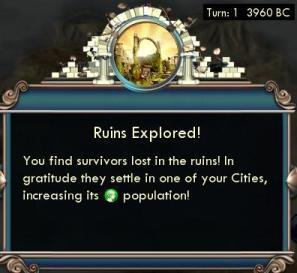 Nice start, Petratastic, and gold is a great planting tile. No food, but that's surmountable. Especially with ruins to size two on turn 1. And another ruin popped culture on turn 7 for the Tradition opener, perfect.
Nice start, Petratastic, and gold is a great planting tile. No food, but that's surmountable. Especially with ruins to size two on turn 1. And another ruin popped culture on turn 7 for the Tradition opener, perfect.Despite a scintillating 183-turn science victory as Korea, I still had to try yet again. Although building widely near-ICS was effective, it was more headachey than fun. And I keep seeing threads on Civfanatics saying how "Four City Tall" is a fine and strong route to a science victory. I've never tried tall science.
And despite what I previously badmouthed about Babylon, I'm going to give that civ a shot here. I had figured the early Great Scientist as insignificant and the GPP bonus as marginal, maybe one extra great person. But now I rethink those positions. Early beakers ARE important, for the reason of reaching Acoustics to unlock Rationalism fast enough for both the Oracle and the 7th natural policy. And going Tradition instead of Liberty means that has to happen 5-10 turns faster.
And Babylon's bonus of +50% scientist GPP might in fact be a serious swing. The one thing that went wrong in the Korea game was insufficient time to produce Great Scientists. I only got two from actual GPP before the late-game flood of non-"free" scientists (Pisa Tower, Porcelain Tower, 2x Hubble) jumped the costs out of reach. Many cities had 400+ GSP that went uncashed. Contrast this to a good culture victory, where every city should and does produce an artist. So Babylon's bonus might actually make the difference in cashing out as many as three extra Great Scientists just in time.
So putting the pieces together, I now hypothesize that the limiting factor for fast science is speed to Education, to building and staffing universities, and thus to Great Scientists. And Babylon pays on both ends of that, first reaching Education faster via the academy and then producing the GScis faster. Lower policy costs with fewer cities might also bring within reach Planned Economy and the +25% science from factories, which I wished for as Korea but couldn't attain. Finally, the early settled scientist will demand an early National College too to multiply it. Civ 5's version of Bureaucracy-Academy.
It's Inland Sea, Large, Emperor difficulty, as I always do.

 Nice start, Petratastic, and gold is a great planting tile. No food, but that's surmountable. Especially with ruins to size two on turn 1. And another ruin popped culture on turn 7 for the Tradition opener, perfect.
Nice start, Petratastic, and gold is a great planting tile. No food, but that's surmountable. Especially with ruins to size two on turn 1. And another ruin popped culture on turn 7 for the Tradition opener, perfect.
Starting build was scout - scout as usual. But they completed quickly with the high hammer start (sheep and survivors), when Pottery was still two turns away. So I switched around the usual plan, deciding to build a worker and buy the shrine. The bought shrine worked out great previously with Korea, and would establish this game's pantheon early enough even if a religious CS didn't show up (which it didn't.) And notice that slow-building a worker is okay because we don't need one immediately, not until Mining, there's nothing we need to farm.
So on turn 13 I bought the shrine. Turn 17 Mining which enabled selling the under-city gold immediately, and that plus a small loan bought my second worker. The two workers connected gold and silver simultaneously, which were sold right away on turn 24 to buy a settler. That's about the fastest any start can ramp up on luxury selling, three within 24 turns.
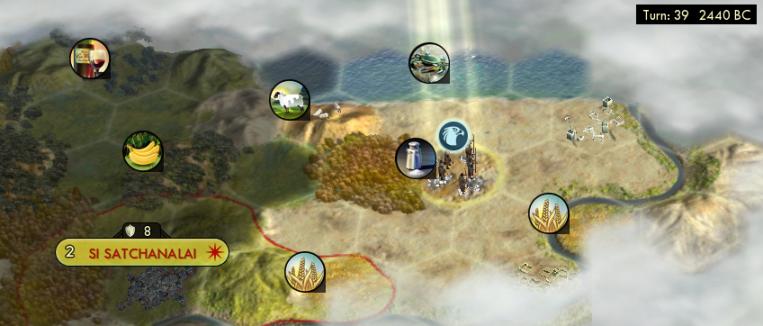
Sometimes the AI is pretty bad at finding ruins. I got quite a number fairly late. 55 gold, survivors to size 4, Bronze Working, Sailing, 60g, a late pop for culture (towards the 5th policy).
So this opening turned out well-rounded. I got a little bit of every accelerator, good in every area but not massive in any: one but only one early culture pop, one unit upgrade (spearman is helpful, though a comp bow would be better), two survivors but the city's growth was rather flatlined for lack of food. And the early bought shrine but no religious CS, which founded the pantheon on turn 28, somewhat worse than average for my speed runs.
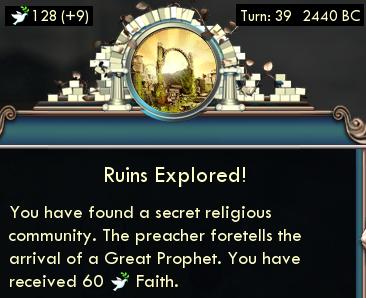
Well, okay, that is acceptable then. Beautiful, the faith ruin makes up for starting Desert Folklore a few turns late.
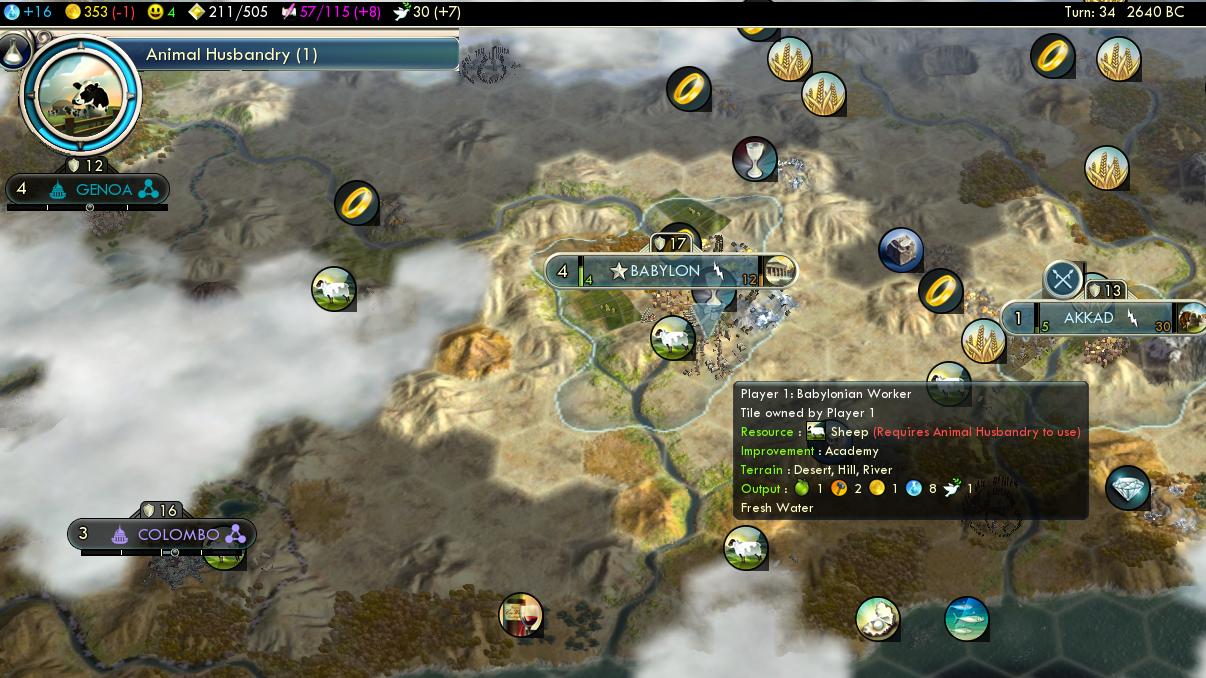
Here's my neighborhood and first expansion. Good enough on desert. Actually, this looks very well suited for a tall build, offering about six city sites at good spacing. Not so many unique luxuries, but that might be acceptable for building tall.
How many cities before the National College is a hotly debated topic. I believe the sweet spot is two. The key point is to keep spending all available cash, don't let money sit idle. The capital alone runs out of things to buy. But a second city can absorb a large quantity of gold, 1520 in all between the settler, library, and two workers. Then the next settler buys occur to match their travel time with the last few turns of completing the NC.
The NC plan proceeded with the usual jump of Great Library to Philosophy. I ran really thin on military, risking building the Great Library with only the single spearman around. This was touch and go, and the silver got pillaged (good thing - resell it after repair), but the GL came in on turn 42. Then I forced myself to build two bowmen before starting the NC. (Hey, Babylon even has a useful UU on top of the sciencey stuff.)
The shot above shows the Academy from Babylon's free Great Scientist at Writing. I learned with joy that this Great Scientist truly is free - it doesn't bump the cost counter! Makes Babylon significantly better than I'd thought.
He built his academy on the sheep. Optimally placing a Great Tile Improvement can take some thought. You want to plant on a good tile worth working, except the best general tiles are flood plains, where you don't want to miss out on the opportunity cost of a +2 food farm. The best spot is a tile that you will work anyway but doesn't surrender a +2 fop improvement until later techs. A luxury would be great since all their improvements just yield gold, except that GTIs don't connect luxes, only strategics.
So ultimately these rules mean a pasture or iron resource, and where the city doesn't have any other such tiles that would invite the extra-hammer building (stable or forge.) Or a Petrable tile. And the sheep is both. Perfect. 2-3-2-8 yield in all, which of course now rapidly ripped through Calendar and Wheel up to Currency.
I had to buy Akkad's library, which is normal for a fast NC opening. On turn 60 the national wonder was done, jumping from 30 beakers to 46. Now the expansion floodgates were open, the usual drill of settle for luxuries and sell them to buy the next settler.
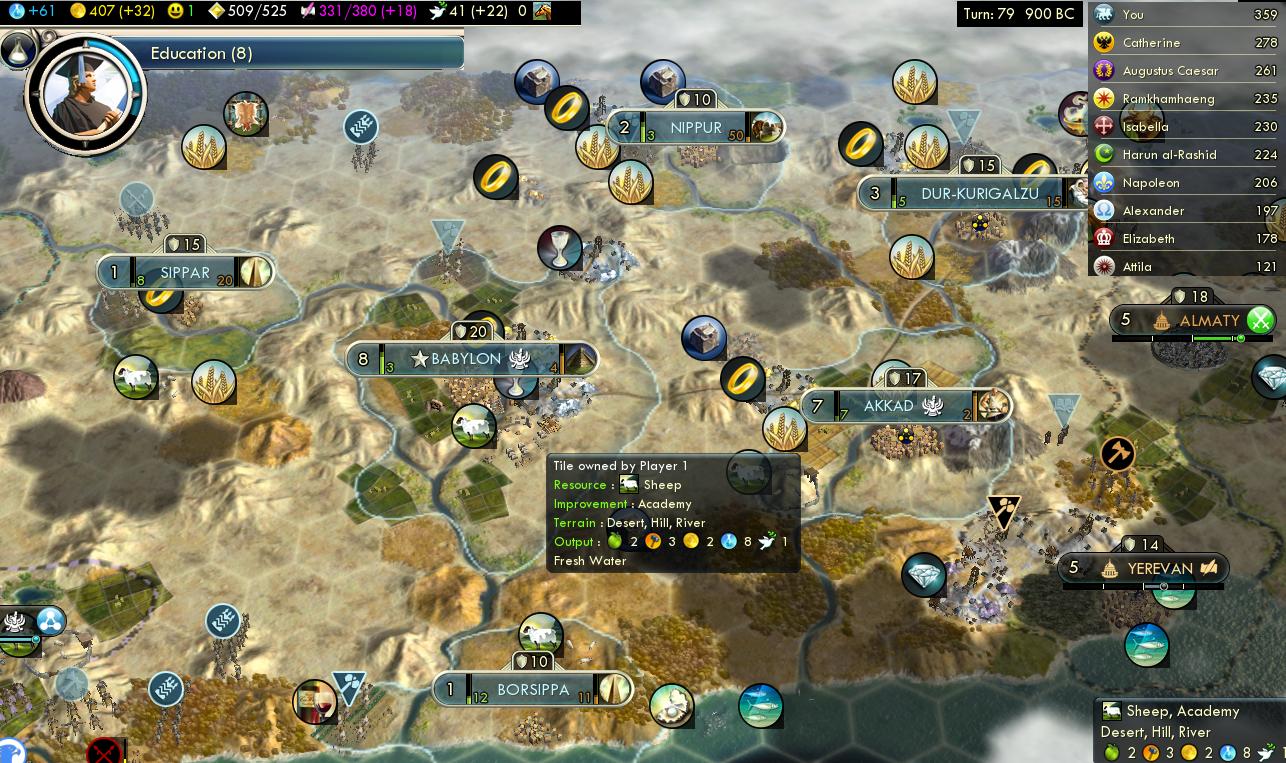
This overview is a short bit after the traditional mark of 1000 BC, since I had several settlers in transit. At 1000 BC my population was only 18, short of my benchmarks in other games. But Petra was already done thanks to the quick research to Currency, whose yield is like having another 7 population.
Here are my six cities. Whether 6 still counts as tall is debatable but I think so. They're spaced out well enough, not competing with each other for workable tiles, and the cities are few enough in number that happiness is not hampering. In fact I limited happiness slightly, selling off lone luxuries, in order to hold off the Golden Age until Chichen Itza there finished.
I'm already researching Education in that picture, and it arrived on turn 87. Hmm. That's just barely enough time to cycle three waves of RAs, where the third would end on T180, which could be just barely fast enough to top the Korea finish. But nah. Early RAs aren't worth much anyway, an RA maturing on T117 probably wouldn't even yield back its gold cost in beakers. I skipped RAs at first to buy universities instead (for scientist GPP more importantly than the beakers), and instead planned for two waves of RAs spanning turns 110-140-170.
Religion had come. I guess the founder belief still has to be Ceremonial Burial, we'll still need happy even building less wide. CB just always seems the strongest of the beliefs. Think of it in hammer terms. CB per spread is the equivalent of 50 hammers worth of colosseums. Compare that to Tithe or Church Property which are worth more like 25 hammers (a quarter of a market), World Church at 33 (a third of an amphitheater), Initiation Rites which is 21 hammers (one-fifth of a bought settler.)
At enhancement time shortly later, I toyed with the idea of Cathedrals, to turn faith into culture. But all of the faith-purchased buildings seem inefficient because each represents opportunity cost of a missionary which would produce 2 happy via CB. A cathedral is actually -1 happy compared to buying a missionary instead. I've run into this problem several times before, taking the Pagodas belief and then hardly buying any over missionaries. They are always a good-enough purchase; they never run out of targets; there's always religionless cities available until the industrial age when faith gets saved for great people instead. And there's no such thing as too much happy via Ceremonial Burial; if you do end up with excess, you can sell more luxuries for money or let it ride to a Golden Age. So missionaries are always good enough that it's not worth spending the second follower belief slot for a faith building.
So instead I went with Swords to Plowshares (+15% food surplus if not at war), which wasn't attractive in the other wide games that incorporated warring, but here I had no plans for anything but peace and my neighbors were content too. And StP looked really good here with tall cities, multiplicative with the Tradition aqueducts.
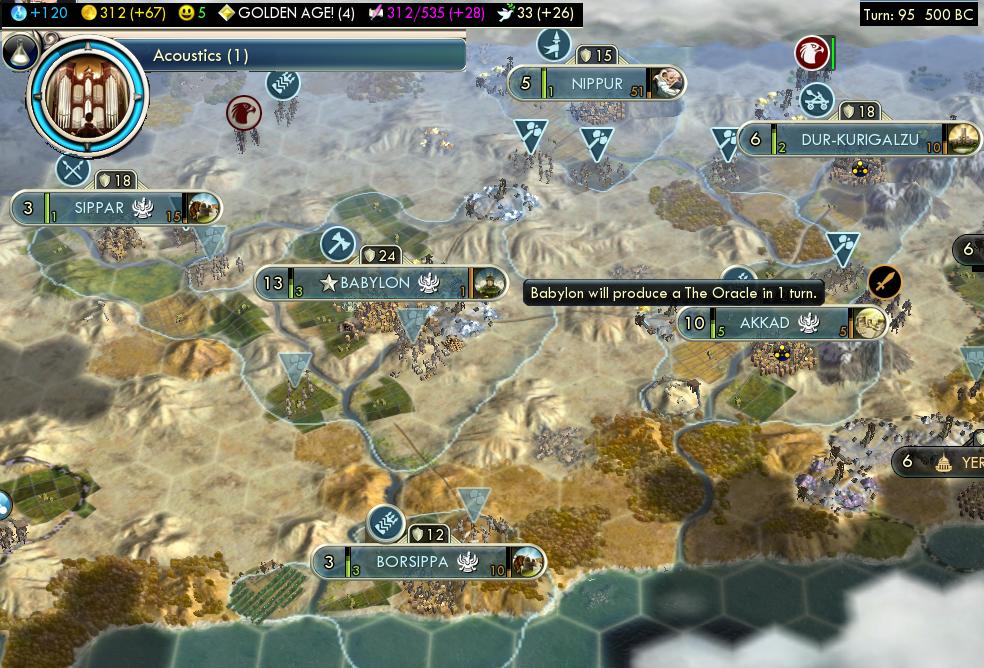
There's my perfect setup, slinging the Oracle into Rationalism as usual. Turn 95 500 BC beats my record for that by at least ten turns. Tradition had arrived on this schedule, pretty standard.
Babylon added a late (T90) Hanging Gardens, a wonder I don't usually get, Petra takes priority at the same time frame. The HG seems only somewhat worthwhile, it takes 40 turns at face value to pay back the 250 hammer cost at 6 fpt. But no, it's very worthwhile: a net cost of only 130 hammers after the free garden, 113 base hammers before Aristocracy, and with a +65% total multiplier on the food (Landed Elite, Tradition finisher, WLTKD, StP) pays back in just 11 turns! (The general benchmark for payback horizon in Civ 5 is more like 30 turns. Workshops, factories, hydro plants, purchased markets, and the like are almost always in this area. This is part of how Civ 5 feels so stiff compared to Civ 4, that there's vanishingly few bargains compared to the cost of everything. Nothing like a Bureaucracy revolt paying back the cost in two turns.)
More generally, Babylon was a very satisfyingly strong capital. Both my Korea and Rome science games didn't really get the capital big enough, because Seoul spent time building settlers instead of growing and Rome kept ceding tiles to nearby cities, and each only had about seven Petra tiles. This Babylon was king of its domain and grew like a rocket after 15 Petra tiles and HG. (Not quite 67 surplus food, but 40 was plenty.) The powerful capital fed back on itself by completing a few more wonders I often skip in Chichen Itza, Great Mosque, Hagia Sophia.
The first natural Great Scientist arrived on turn 98. Bulb or academy? The academy would be worth 10 + 100% (after Sci Meth and Free Thought) + 15% for Rationalism = 23 beakers. For 80 real turns plus perhaps 80 virtual turns by way of 10 bulbs. 23 x 160 = 3680 beakers. Wow, that is not remotely close to the value of an endgame bulb at 8000 or more.
50 AD, comparing some numbers, this Babylon is at 246 beakers compared to Rome's 200 and Korea's 210. But the thinner build is behind on population, 68 to Rome's 83 and Korea's 103. We'll see where this goes.

I always love sneaky swipes of barbarian camps. 100 influence for free.

Even lowly scouts can pull that off by being in the right place at the right time. 95 influence including the return of the worker.

Barringer Crater allows an observatory. Uh, that would be exactly the opposite of a mountain peak.
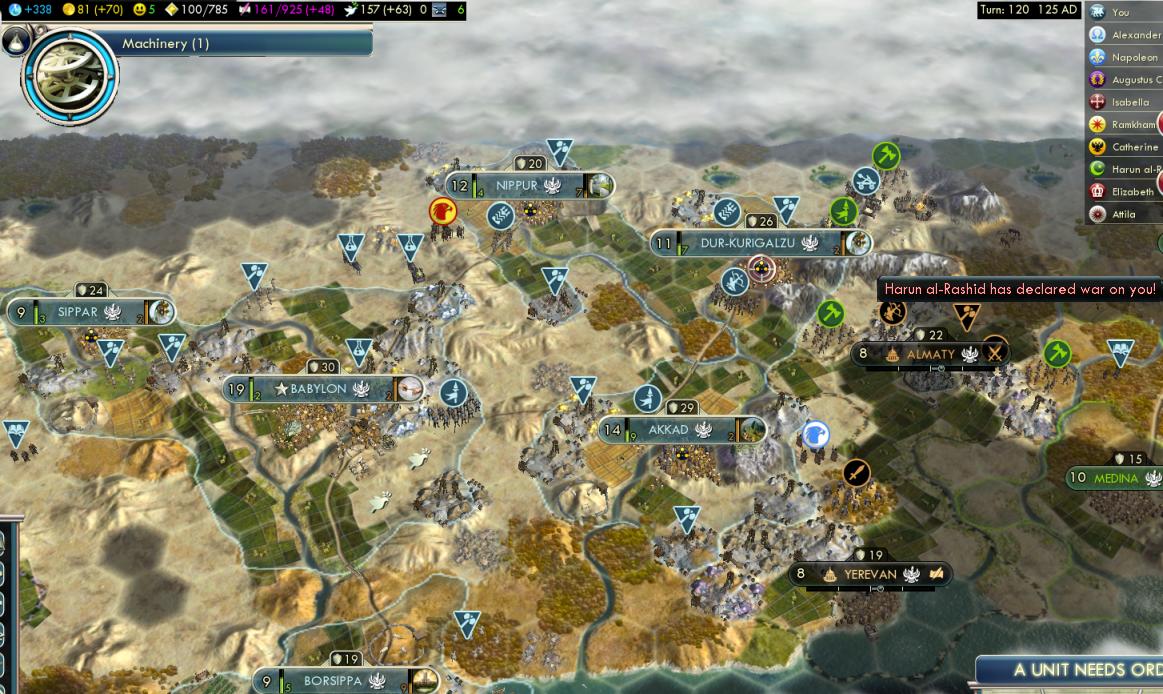
Presently came my one and only war of the game, with Arabia declaring on me, easily foreseen from a million miles away. And notice how scattered that front is - there's no way the AI could actually get a consolidated army through those mountains and city-states. Any trickle of a few units at a time gets slaughtered in any Civilization game, and so it went here. Just Babylon's Bowmen were enough to hold it off, though I started upgrading to crossbows anyway.
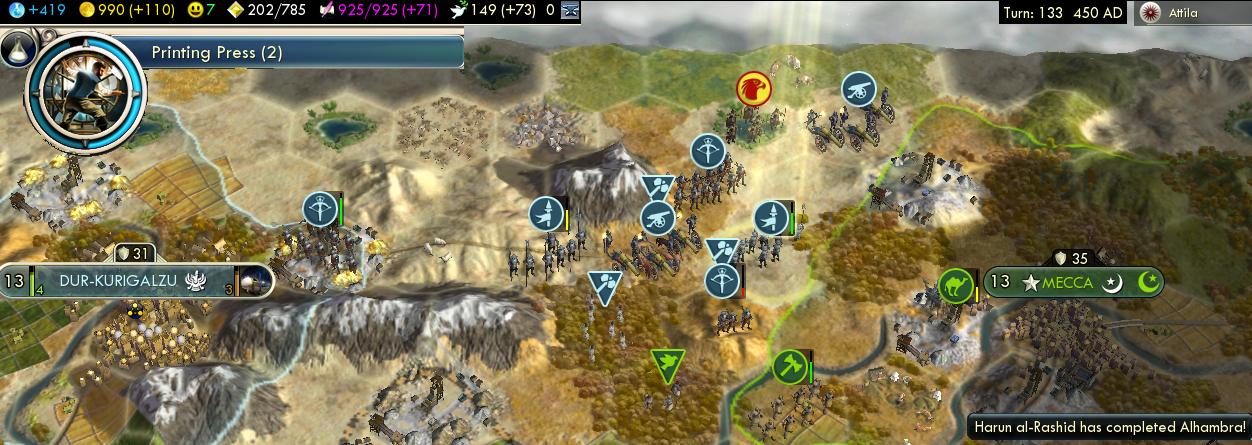
In order to go capture Mecca, with the addition of two cannons. Yeah I wasn't going wide, but this was too juicy a target to resist. A city with three wheat, two luxuries, and oh yeah Alhambra should support its own happy and policy costs and cleanly bolster my overall research speed. No more of Arabia was worth conquering (and Mecca actually killed a few of my units) so I extorted his treasury for peace.
However despite the three wheat and a bought aqueduct, this city still didn't manage to grow much, because the time frame to the end of the game was already surprisingly short. Mecca only grew from size 6 to 12 under my control, and only built some of the research buildings, not reaching the lab.
But it turned out as a vital move for a completely different reason: this city turned out to have my only source of coal! Better to be lucky than good.
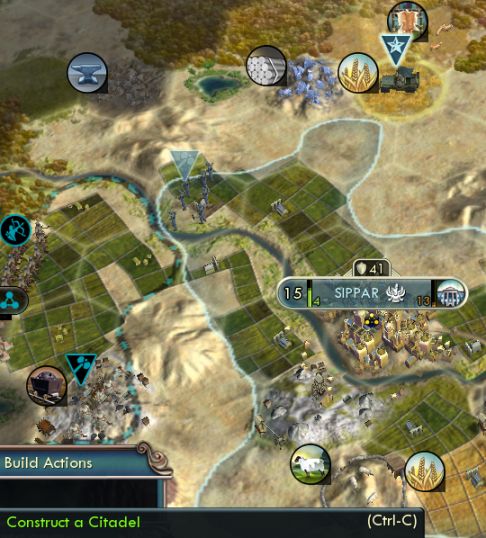 Not only that, but that war also critically supplied aluminum by this roundabout method of spawning a Great General. (I had one other source, but it wasn't enough for all the hydro plants and spaceship parts.)
Not only that, but that war also critically supplied aluminum by this roundabout method of spawning a Great General. (I had one other source, but it wasn't enough for all the hydro plants and spaceship parts.)
Time for my usual overview and statistics at 800 AD.
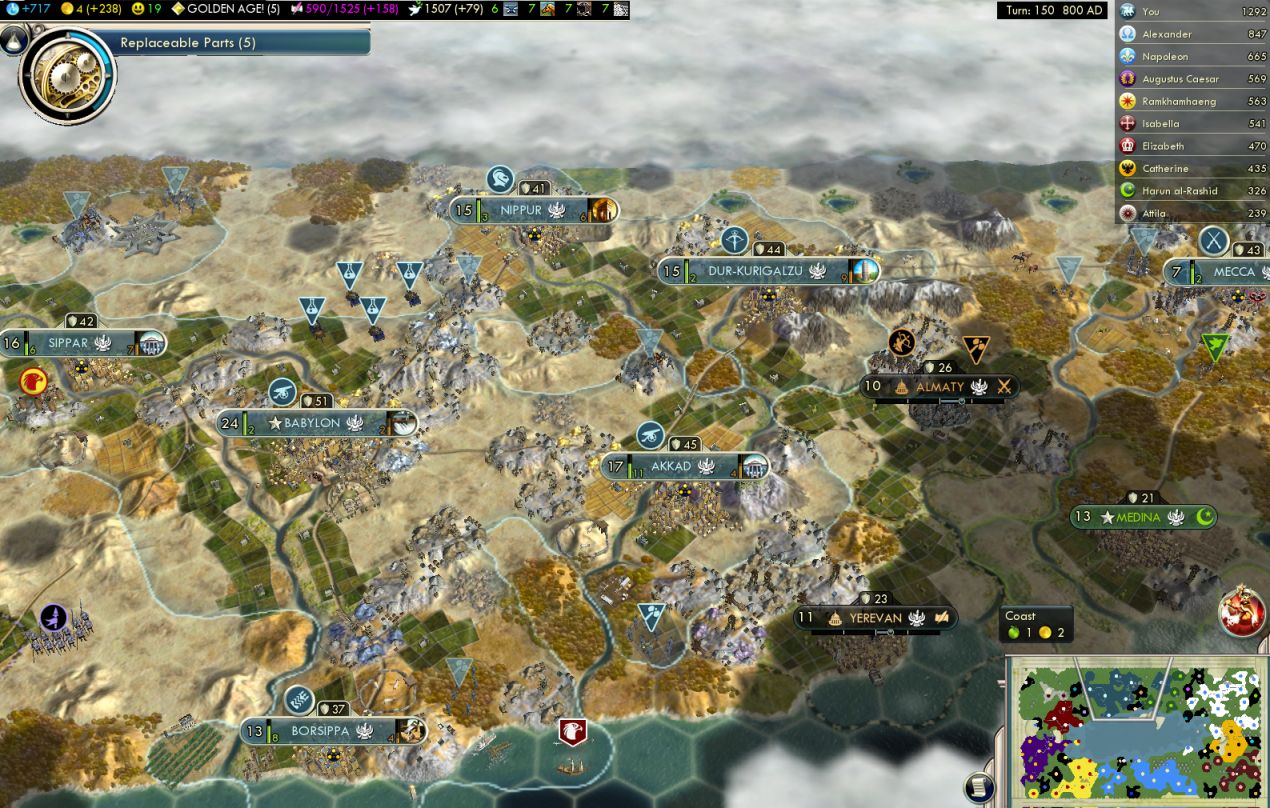
| Korea | Rome | Korea 2 | Babylon | |
| Beakers | 683 | 632 | 943 | 717 |
| Gold | 119 | 168 | 66 | 238 (GA) |
| Culture | 72 | 141 | 170 | 158 |
| Policies | 10.0 | 10.5 | 11.2 | 11.3 |
| Population | 128 | 140 | 198 | 97 |
| Researching | Electricity | Radio | Rep Parts | Rep Parts |
| Crops | 404 | 386 | 635 | 281 |
| MFG | 280 | 273 | 383 | 286 (GA) |
As I suspected, not quite keeping up with the raw beaker count of the widest Korea game, but actually surprisingly close on only half the population.
Progressing on, this build with a moderate number of cities was actually quite a bit more fun than my previous near-ICS tries at science. In particular, the happy cap mostly managed itself, ramping up on its own with Ceremonial Burial expansion and a few city-state quests. It was definitely nice not having to spend hammers on Notre Dame or Forbidden Palace, or a policy on Humanism, or money on city-states for happy (most games need to do that several times.)
In fact, for a while I didn't have any urgent demands for money at all. I wasn't bootstrapping new cities with workshops, or more generally didn't have any cities so late and weak that they needed bought buildings. Already had RAs in place... actually the right money move at the moment was to save up ahead of time for the second round of four RAs. The first round of four RAs matured at turn 140 for 1500-2000 beakers each, a healthy number, much better than cramming them in immediately after Education and getting barely 300 beakers per RA. (They went for Sci Theory, Electricity, Industrialization, Metallurgy, nicely speeding up to public schools and hydro plants.)
So I really liked how smoothly the later game went here. Built Opera Houses while building Big Ben and saving money, then bought discounted Public Schools. Built Hydro Plants while waiting for culture up to Planned Economy, then built discounted factories.
The later policies came in like this. I targeted Planned Economy, which meant a serious culture push by building Opera Houses and the Hermitage, plus filling artist specialist slots at least some of the time. This occurred and was worthwhile: the 200 hammers invested in each Opera House would get paid back by saving 180 on each factory. (Factories are absolutely necessary for the science game, as a prerequisite for the Spaceship Factory building.)
So yes, reaching Planned Economy as a 12th policy is possible with a tall build. In fact, I think that might be the critical inflection point on choosing wideness for science. Like the correct wideness for culture is just enough science power to research to Sydney Opera House, perhaps the correct wideness for science is just enough restraint for culture to still reach Planned Economy (on top of Tradition and Rationalism of course.)
As I mentioned at the top, the key to the Babylon game would be Great Scientists.
I've finally come to properly understand Great Person generation in Civ 5. It's very much unlike Civ 4, where the approach is to pile a dozen specialists of whatever types into a National Epic city to reap 100+ GPP per turn or 300+ in a Pacifism Golden Age. Great People in Civ 5 are much more methodical and require long-range planning. With so few GPP multipliers and specialist slots, to produce any Great Person you must start as early as possible and run maximum specialists of that type at all times. And the deadline for producing any Great People at all is the late industrial era, before the costs jump with the non-"free" GP awarded by the Pisa Tower, Porcelain Tower, Hubble, and Louvre.
So I planned far far ahead on Great Scientists. I identified the cities that would produce GScis at the 400, 500, 600, and 700 levels, and built Gardens in the latter two and National Epic in the last. I very carefully managed the 600 city to spawn just ahead of the National Epic city which went on to 700. That came on turn 168, and I had set up to immediately complete both the Pisa and Porcelain Towers the next turn, the latter exactly in time for the second wave of RAs.
I made one mistake in the later game here: built the Louvre for a golden age. Of course you want the GA for spaceship part building (I'd done Taj Mahal much earlier), but I could have gotten one with the second happy GA instead by pushing on trading for luxuries. The Louvre was a mistake because it ended up delaying Apollo Program a few turns, which turned out to be a limiting factor.
So with that careful planning, I'd have a total of 13 Great Scientists for bulbing! (7 natural and the standard six "free" from Pisa/Porcelain Towers, Hubble, and two from faith.) With that many bulbs in pocket, better start early.
These were not incorrect, despite the low yield. I needed Plastics early to add the Research Lab specialist slot to squeeze out that last 700-point natural Great Scientist. So that was as if these two GS replaced themselves with one more.
Now could wait a moment on bulbing, since the limiting factor on tech was now culture, the Rationalism finisher would pick up the final two techs.
Man, six bulbs before and towards Rocketry wasn't enough. Apollo Program still became the overall limiting factor. One thing Civ 5 does better than Civ 4 is make the spaceship endgame actually depend on both research and production - somehow even with far fewer parts at lower costs.
T176 Hubble done, and now bulb everything with the last seven scientists. 9600 beakers each: Combined Arms, Computers, Robotics, Penicillin, Ecology, Telecommunications, Mobile Tactics. This resulted in 15k beakers overflow, although that didn't matter since the Rationalism finisher was already lined up for the last two techs.
T177 All at the same time, Apollo Program done and Rationalism finisher, claim Particle Physics for the last SS part and a second tech that didn't matter. As usual, I micromanaged everything for hammers, and sold massive quantities of now-obviated science and culture buildings to buy SS factories.
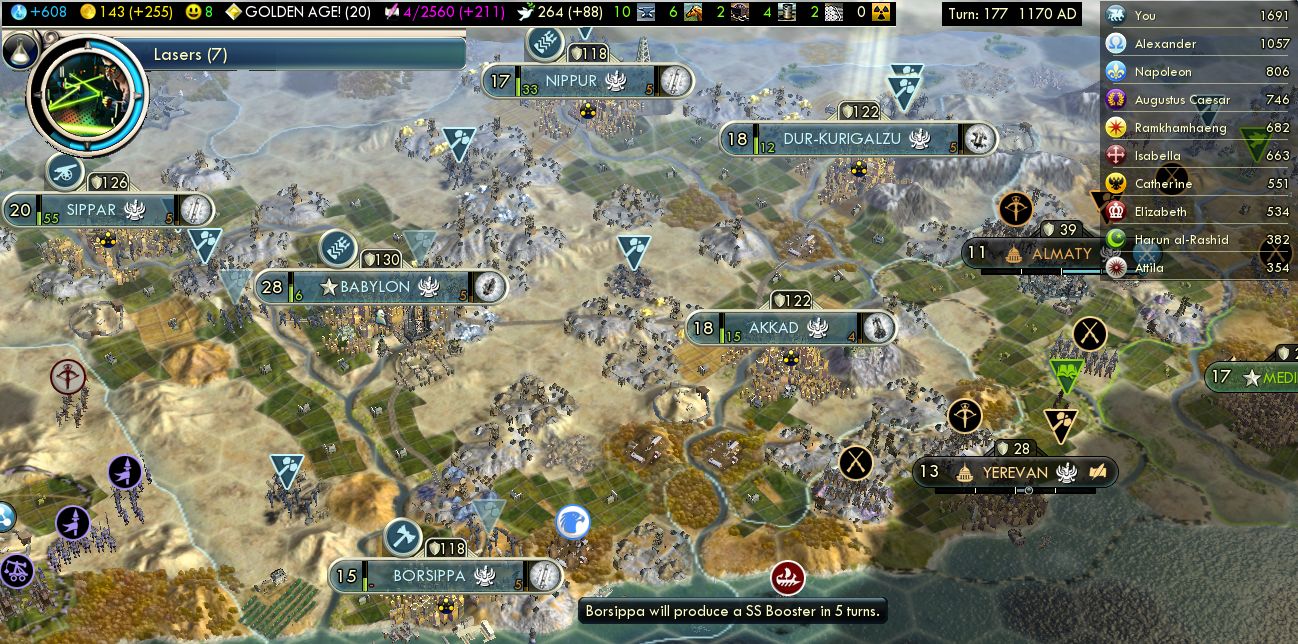
Perfecto. Five turns to the SS parts in all cities. Cutting off one more turn proved impossible in Borsippa so that was that. I did squeeze out Dur-Kurigalzu's part one turn sooner, just in case some enemy unit (like that incoming green missionary on the right) got in the way on the railroad track. I covered up the railways from other cities with my own units to block any other such shenanigans.
Science Victory on turn 182 1220 AD. Hah! One turn faster than Korea! But considering Korea's last turn lost to moving the ship parts, it's a tie!

So what did we learn here?
Wide obviously isn't necessary for science. A city count of 6-7 does work fine. Relaxing the happiness constraint did help quite a bit more than I expected. Wide happy is always solvable, but the opportunity cost can be steeper than you realize. Selling luxuries instead of buying them and city-states means money to slam out those Public Schools and Research Labs. Tall also means you can go Tradition which still rocks, and then pull in enough later policies to reach Planned Economy on top of Rationalism.
Babylon is good. It does result in a lot more Great Scientists than the GPP math would indicate. Because the key factor isn't just GPP production, it's squeezing GPP production in a very particular window between Education and the late wonders. I hadn't realized before how Babylon's abilities synergize, extending that window with earlier Education then filling it with multiplied GPP. Babylon was not so strong pre-expansion, when the assorted free GP really were free so you could continue to produce natural ones later.
Still, I think this game wasn't perfect. I now see that my Korea game went significantly wrong in the area of Great Scientists, naturally producing only two. It's critical to carefully manage GSP to squeeze out probably up to the 500-point GS _before_ building Pisa/Porcelain/Hubble. Korea also went wrong by skipping the National College, which gets you to Education and GSP sooner than any amount of wideness.
And also my Rome run was the only one that really got the endgame right. You must bulb to Rocketry surprisingly soon, and make darn sure the capital's schedule is cleared out from any other distractions like Louvre or Oxford or Statue of Liberty. Get Apollo done four turns sooner, and all the side cities start their parts sooner, letting you finish only 2-3 turns after the last tech instead of five.
Will I play yet another game to bring all those details to perfection? I don't know. Maybe.